Detention Basin
Today, engineering and birds. The University of Houston's College of Engineering presents this series about the machines that make our civilization run, and the people whose ingenuity created them.
Hurricane Ike did great damage in Houston. It dumped rain, ripped off roofs, and drove flood waters. Still, the streets in our neighborhood stayed fairly dry. The next day, I walked over to our swollen bayou and found the flotsam had stopped two feet short of the lip. We'd had some damage, but we'd been spared flooding.
Soon after, I noticed a new pond near the bayou, two miles upstream -- secluded, almost inaccessible. A dirt driveway turned off the freeway feeder on the other side of it, so I parked, got my camera, and slogged in through the muddy brush. The pond lay at the bottom of a large hollow. As I picked my way down the side, the freeway noise fell away. Here, in the midst of America's fourth largest city, was a lovely world of water birds and quiet.
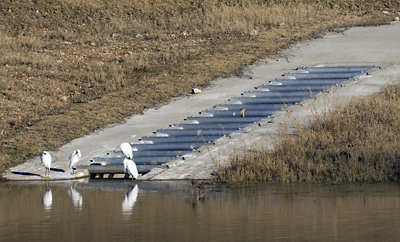 A 400-foot long concrete weir separated the bayou from this artificial pond. When the bayou filled up, water would clearly overflow the weir into this basin. This was geography rebuilt, and it is what saved so many homes downstream, during the hurricane.
A 400-foot long concrete weir separated the bayou from this artificial pond. When the bayou filled up, water would clearly overflow the weir into this basin. This was geography rebuilt, and it is what saved so many homes downstream, during the hurricane.
This is one of the smaller such basins scattered about Houston -- 7 acres of water on an 11-acre plot of land. They're called detentionbasins because they only detain the water. Outlet tunnels let them drain back into the bayous as the bayou level drops. It's a completely passive system -- no pumping needed.
The pond stays six feet deep since its bottom is clay-lined. Water doesn't soak back into the ground during dry periods. Right now, the pond level is just at the bottom of the return tunnel. That clay lining guarantees this will be wetland all year long.
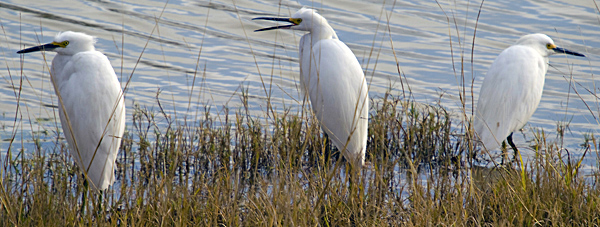
Later, the City will add footpaths and other amenities, just as the County has done with many much larger outlying basins. The County has made their basins into a remarkable set of parks and bird sanctuaries. Yet this modest basin is still pretty large. They excavated almost a fifth the volume of the Great Pyramid as they hollowed it out. It can hold 89 million gallons of water.
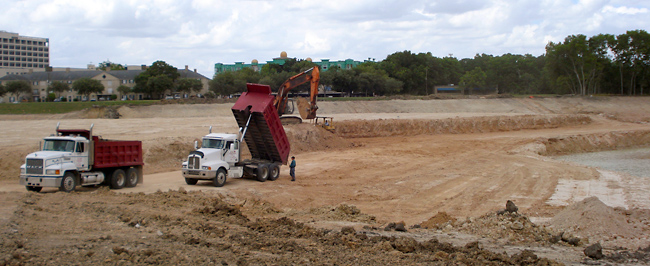
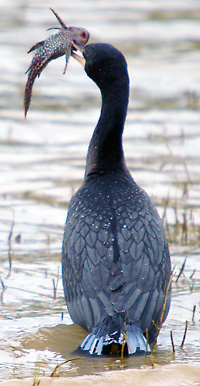 And I feel downright possessive of it. It's not yet a hiker-friendly space. I'm alone with mud on my shoes and the birds. It's my own private temple. The pond is rich in fish. How did they arrive? The bayou overflow swept fish in; and wading birds unwittingly carry fish roe in on their feet.
And I feel downright possessive of it. It's not yet a hiker-friendly space. I'm alone with mud on my shoes and the birds. It's my own private temple. The pond is rich in fish. How did they arrive? The bayou overflow swept fish in; and wading birds unwittingly carry fish roe in on their feet.
So I watch birds circling and feeding: snowy egrets and great white egrets, roseate spoonbills and cormorants, lone blue herons and ospreys (solitary hunters that they are), willets, occasional flocks of gulls, and a trio of Canada geese.
Few cities are as eco-friendly as Houston. Each of our many bayous is a nature preserve winding through all the activity. We're wed to a living system of waterways that evokes the best from the engineers who manage it. That's why all thought of the great construction that made this lovely spot disappears. And we're absorbed into the restful wheeling of a glorious avian diversity.
I'm John Lienhard at the University of Houston, where we're interested in the way inventive minds work.
I am most grateful to Kurt Roedel, Project Manager of the Brays Bayou Detention Site (which I describe in the text) for counsel and information. BRH Garver Construction LP built the site for the City of Houston. CEO Mike Garver is a key member of the Buffalo Bayou Partnership -- dedicated to the conservation and cleanliness of the Houston's primary bayou artery.
The Brays Bayou Detention Site required one year of steady digging with 2 or 3 backhoes working each day. Some 440,702 cubic yards of dirt, or 62,957 truckloads, were removed. The 7 acre pond is designed to handle 273.2 acre-feet (89,021,804 gallons) of water.
I am also grateful to Heather Saucier, Spokeswoman for Harris County Flood Control District, for her counsel and for first suggesting that I do a program on the detention basin system. For more on the Harris County Flood Control District, `see its website here.
Construction site photo above and flap valve below by Kurt Roedel. All other photos by John Lienhard.
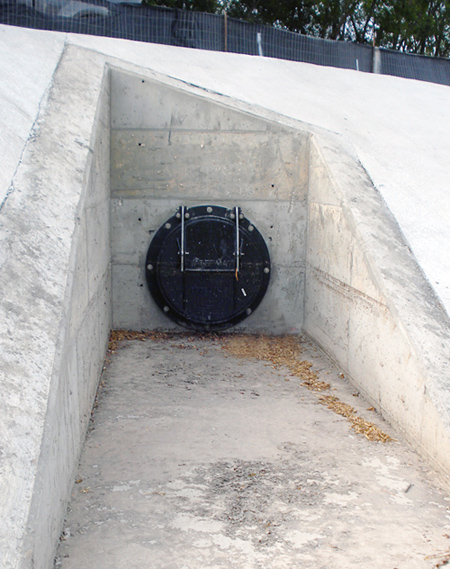
Flap valve that allows water to flow from the pond back into the bayou after a storm. The valve is very heavy and opens only when there is enough backpressure head behind it.
